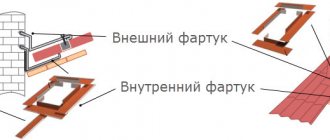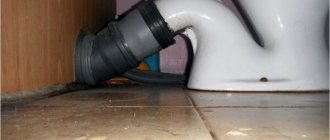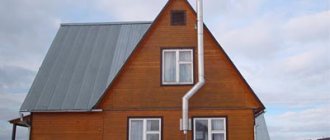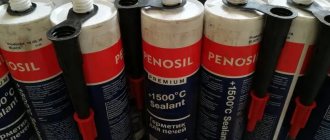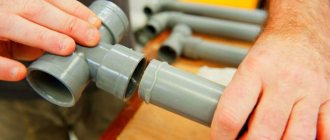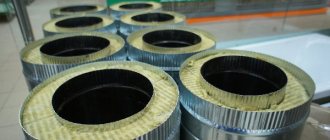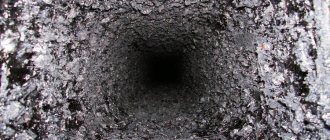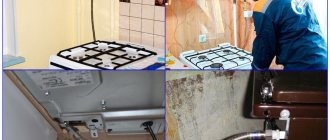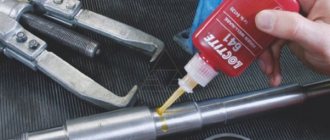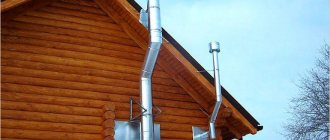The service life of heating sources, boilers, stoves and fireplaces solely depends on the method and material of chimney sealing. This operation is mandatory for every smoke removal system, since even the most high-quality installation of boiler equipment does not guarantee the absence of gas contamination in the premises due to the penetration of flue gases. Leaks in gas ducts can be caused by temperature deformation, leading to ruptures and cracks in the structure. A leaky gas exhaust system is not capable of creating working draft in the boiler unit. As a result, soot accumulates intensely in the pipe itself. This has the potential to become a prerequisite for a fire in the chimney. In order to counter this dangerous phenomenon, you need to know how to seal the chimney.
Purpose of chimney sealing
In order to prevent smoke from leaking through cracks, sealing the chimney is an indispensable condition for its functioning. High-tech heat-resistant seals are used to seal the joint seams of various elements of prefabricated chimneys. In addition, they are used for emergency repair of leaks formed during the operation of heating sources in winter, when it is not possible to disconnect the boiler and replace damaged areas.
Such materials are used to seal cracks in a classic chimney made of brick. Previously, traditionally, clay was used for this, but it is short-lived. In addition, heat-resistant pastes are used to treat the exhaust pipes to the roof - this protects the rafter system from getting wet and rotting.
How the sealant works
All types of sealants for work in high-temperature zones are divided into 2 fairly large categories - heat-resistant based on silicone materials and heat-resistant with silicate technology. They differ in content and acceptable operating properties. All sealing materials can be divided into several types:
- silicone or silicate technology;
- by content: from one component or two;
- according to temperature indicators: temperature-resistant sealants and heat-resistant.
How the sealant works
All heat-resistant polymers are applied to the defective area between the chimney and the roof, after which they harden or polymerize under the influence of the atmosphere for some time.
For home use, one-component kits are used - they harden more slowly, making it easier to correct any errors during application. In industrial production, binary sets are used in which the paste is mixed with a hardener.
What to look for when looking for sealant
When choosing a sealant, the following points must be taken into account:
- Operating conditions of the heating device;
- Location of the joint or seam (inside the pipe, outside the chimney or on the roof);
- Temperature regime of the treated surface: Heat-resistant agents are mainly used to seal chimneys
- Consistency and composition of the sealant: solid silicone is best used for cracks in brickwork;
- Material for the manufacture of chimney elements.
A properly selected sealant will save you from unexpected expenses for cleaning or disassembling the chimney installation.
Criterias of choice
Before you make a choice about how to seal your chimney, you need to understand that effective means of protection in the smoke ventilation system are not cheap. You should not save your money on heat-resistant sealants. It is safer to purchase these materials from popular brands and in large shopping centers, but it is recommended to keep your receipt. High molecular weight silicone is an expensive material and sometimes there are counterfeits on the Internet.
There is a simple option for checking the material than sealing the gap. If several bottles are purchased, then squeeze out a little of the substance from one, wait until it hardens, and set it on fire. Real silicone is difficult to ignite and burns with the release of a mixture of dark and light soot - hydrocarbons and silicon oxide. Fake sealant, usually containing acrylic and PVC, burns and releases only black soot.
It should also be noted that heat-resistant sealants for furnaces and flues are sold in tubes for a construction gun. If the store recommends polymer in classic tubes, most likely it is all a sealing material for cars; it is acidic in nature and is absolutely not suitable for heating devices and gas ducts. In this regard, carefully study the instructions on the packaging before sealing a stainless steel chimney.
When studying, you need to especially pay attention to the following characteristics:
- Permissible temperature. It must meet the operating conditions in the hot zone.
- Working environment. The sealing material must be neutral.
- Manufacturer's brand. Popular models of heat-resistant sealants are Penosil up to 1300 C, Makroflex up to 260 C, and domestic “Moment Germent”.
- Price. Silicone polymers are much cheaper than silicate ones.
Types of sealants
One-component sealants are made from a single ingredient and do not require mixing of the elements before performing the sealing procedure. This makes them easy to use and in demand among the owners of individual cottages, who appreciate the quality of such material for insulation work.
Binary or two-component, before work you will need to mix, exactly following the ratios noted in the annotation. At the same time, the prepared product must be completely consumed within a few hours after mixing. This method is not very suitable for sealing seams at home; as a rule, it is used by highly professional builders.
Silicone materials
For convenience and ease, the chemical industry produces a wide range of silicone seals. Such sealants are divided into:
- For acidic ones. When heated and combined with certain elements, acetic acid is released. They should not be used on items that are vulnerable to rust. Due to the above, connections are formed that prevent the optimal operation of the chimney, and its sealing is disrupted.
- Alkaline sealants.
- Heat-resistant silicate-based sealants can withstand fairly high temperatures. They are most used in areas with open flames. They can also be used in leakage areas of heating boilers and installation areas.
At the moment, an adhesive-sealant is presented on the construction markets, capable of being used in very difficult areas, where ordinary material is not tightly fixed. In terms of characteristics, the glue is no worse than similar sealants, and in some ways it is even more advanced. As a result of its use, the strength of the assembly is achieved, a very long-term joint appears, which is practically not affected by external factors.
Heat-resistant products
Heat-resistant sealants are produced on the basis of silicones - organosilicon oxygen-containing syntheses and can withstand ambient temperatures up to 300 C, which exceeds absolutely all conventional elastic seals. They have a long service life, elastic, inert in chemical environments, moisture-proof, very stable to biological influences, solar radiation, capable of functioning under rapid changes in temperature conditions, non-toxic and environmentally friendly.
Heat-resistant silicones are produced in the form of a red-brown paste. The sealant is colored by iron oxides. Design temperatures range from 180 to 310 C, this information is indicated on the packaging.
Silicone use area: sealing the external areas of the chimney, structural joints of the chimney and roof, blind cracks in brick areas, sealing steel pipes, as well as stainless steel structures. A special advantage of heat-resistant sealants is their elasticity. The width of possible compaction is up to 6 mm, the polymerization period is up to 25 minutes. Compaction is performed at positive air temperatures, no more than 45 C.
This sample of sealing materials has a silicone base with the addition of iron oxides. Such additives with a reddish tint not only increase the temperature resistance of the sealant, but also make it inconspicuous when treating brick chimneys. They keep the sealed gap tight for a long time.
Heat-resistant seals
They are used for sealing and repair work on the internal walls of the smoke ventilation system, combustion chambers, brick pipe ducts, wells, joining seams of cast iron and metal parts with the masonry of the heating source, mounting points for sandwich chimneys use fire-resistant silicate polymers operating in a temperature environment of up to 1200 C and short-term – including 1500 C.
Silicate sealing materials are distinguished by black or black-gray color and viscous consistency; they harden within 20 minutes after surface treatment is completed. The seam width is up to 20 mm. Heat-resistant silicates form a low-elastic compound. The ambient temperature during processing operations should be between 1 and 40 C.
The chemical industry has enterprises that produce specific heat-resistant compounds for lining heating devices and chimneys with thermal slabs: fireclay, clinker and porcelain stoneware, as well as facing stone. Typically, they are all produced on the basis of silicates and contain liquid glass, clay, cement, plasticizers and polymer additives.
Such consistencies tolerate temperatures ranging from -25 to +200 C and even more. The industry also uses other high-temperature similar compositions; they seal leaks in large volumes, and drying joints requires powerful heating, so they have not gained popularity in everyday life.
Scope of use of stainless steel pipes
First of all, stainless steel pipes are used in the construction of water supply, heating and sewerage systems. It is here that the pipeline is constantly exposed to water, and ordinary metal products are destroyed and rusted. Limescale deposits form on the inner walls of conventional steel pipes, which gradually narrows their diameter. As a result, communications must be repaired or replaced.
Stainless steel pipes are completely free of these disadvantages. The only thing that somewhat limits their widespread use is the high price. Therefore, they are more often used in large centralized supply pipelines.
At enterprises producing food for the population, food grade stainless steel pipes are in great demand. These products are not only resistant to corrosion, but also to the formation of plaque from microorganisms and fungi.
This useful quality is ensured by a perfectly smooth inner surface. Through the pipes
move food solutions and prepared food products without any damage to their quality. Finished products, for example, milk or lemonade, are bottled through stainless pipes, which cannot replace plastic or metal products.
Stainless steel pipes are used in the construction of large pipelines for the delivery of oil and gas. The well-known streams that transport fuel to many countries around the world are made using this technology. At chemical plants, many tons of aggressive chemical solutions, including alkali and acid, are distilled through these pipes, without the slightest damage to them.
And it is now impossible to imagine the modern production of cars, ships and other vehicles without stainless pipes. They are not only used as elements that protect the main components and assemblies from corrosion, but also create with their help special strength in combination with an attractive appearance.
Stainless steel profiled pipe has been used in construction and interior design:
- It is used to create stylish elements outdoors that not only decorate, but also withstand high mechanical loads.
- Inside commercial and residential premises, beautiful and durable arches, railings and fences are made from it, which emphasize the overall style.
Railings made of profiled stainless steel pipe
In the production of furniture, such products are irreplaceable; even the expression “furniture pipe” has appeared. Load-bearing structures of beds, sofas and armchairs are assembled from it.
Separately, I would like to say about the use of stainless steel in the construction of stoves, fireplaces and other heating devices. Recently, a chimney made of stainless steel pipes has been used more and more often. A small, lightweight stainless steel pipe is replacing bulky brick structures. The fact is that fuel combustion products, which are characterized by high temperatures and chemical compositions that negatively affect traditional metal and asbestos products, are removed through the chimney.
The options for using stainless steel pipes are very wide; in order to list them all, a separate large review is needed.
Stainless steel products have undoubted advantages:
- high reliability and durability;
- corrosion resistance;
- ability to withstand high temperatures;
- resistance to many substances, the chemical composition of which negatively affects ordinary materials;
- high aesthetic qualities.
Production Features
The production of these products differs from conventional materials in that during the melting process elements are added that impart strength and other properties to the steel. First of all, it is chromium, titanium, nickel and molybdenum. It is chrome plating that makes stainless steel products resistant to corrosion and gives them a shiny appearance.
Stainless steel pipe is produced in two ways: seamless and welded.
With the seamless method, steel is poured into a workpiece in the shape of a pipe, then the calibration process takes place and the surfaces are processed inside and out. Processing can begin in a cold or hot state of the product, respectively, they are called cold-deformed and hot-deformed pipes. The advantage of this method is the special strength of the products and the ability to produce pipes of any thickness.
The manufacture of products by welding has become more widespread. Its essence is as follows: a flat sheet is taken, rolled into a pipe, and the connection is made using a special welding device. Next, the products also undergo a process of calibration and surface treatment.
By the way, profile stainless steel pipes – square and rectangular – are produced in exactly this way.
Rules and principles for sealing chimneys
When working with two types of polymers, it is necessary to prepare the surface of the flue: clean, remove dust and dirt, and degrease. Metal areas must be sanded with fine sandpaper for effective adhesion of the polymer material. The surface under the heat-resistant seal must be absolutely dry. The tube is inserted into the gun and a small amount of material is squeezed onto the edge to be sealed. They provide the opportunity to harden; the polymerization time is usually indicated on the packaging.
The base for the heat-resistant silicate polymer is prepared and slightly moistened. Carefully apply the sealant to seal the gap tightly and allow time to harden. Excess heat-resistant mass is removed before it petrifies. It is possible to pre-glue the length of the seam with masking tape, and then remove it after completion. Activities are recommended to be carried out during the warm period of the year.
Some important rules when using heat-resistant sealants:
- Work with silicate sealing components is carried out in a temperature range from +6 to +41 C.
- The desired connection result is achieved only in the case of rough and uneven surfaces. For this purpose, when used, the areas are pre-treated with grinding materials.
- The surfaces must be degreased with a solvent, after completing the stage, allow them to dry for 20-25 minutes.
- When the mass hardens in the areas where the sealant is applied, very strong and hard seams are obtained; for this reason, it is not recommended to use these heat-resistant kits for systems operating in conditions of high vibration.
- The remaining sealing material is removed with a damp rag, but only until the paste hardens. After polymerization, this will require the use of force and tools.
Popular manufacturers
There are quite a few companies producing pyrogenic sealants in the construction market today; the most famous brands include:
- The presented company produces both heat-resistant and heat-resistant sealing products. The heat-resistant material is made on the basis of red silicone acid paste, resistant to high temperatures up to 300 C. There is a heat-resistant modification of the material for Penosil-1500. This substance is black in color with a maximum operating temperature of up to 1500 C.
Penosil-1500 - The brand sells heat-resistant products from the Polish company Selena Group. The sealants of this model can withstand ambient temperatures up to 1250 C. The presence of a fiberglass mixture in the material’s formulation creates smoke- and gas-tight seals, thanks to which the sealant is in deservedly high consumer demand among craftsmen.
Sealant from the Polish company Selena Group - Soudal C. A Belgian company that produces a wide range of sealing materials, including pyrogenic ones, for example, Soudal Calofer, Fix All and some others. Soudal C.
High-temperature sealants are considered an indispensable product in the construction of smoke ventilation systems for various boiler equipment, stoves and fireplaces. They have many significant positive qualities and specific properties. Therefore, on the eve of purchasing a sealant, it is necessary to carefully familiarize yourself with its parameters and the advice of qualified specialists. All of the above makes it possible to insure against miscalculations and make the best selection of sealant, in which the tightness of the chimney system will be guaranteed.
Cement
Sealing a chimney with cement has been a long-forgotten method since the last century. However, it is still used today. The binding agent in this case is an asbestos-cement mixture in a 1:1 ratio.
The mixture is prepared by hand as follows:
- I fill the asbestos with water and bring it to a homogeneous mass;
- A homogeneous and swollen mass of asbestos is mixed with a portion of cement;
- The mixture is coated with the joint between the roof and the chimney;
- Operation of the chimney system is possible after the sealing mixture has completely dried.
